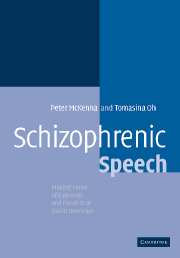Book contents
- Frontmatter
- Contents
- Preface
- 1 Describing schizophrenic speech
- 2 Thought disorder as a syndrome in schizophrenia
- 3 The differential diagnosis of thought disorder
- 4 Thought disorder as a form of dysphasia
- 5 Thought disorder and communicative competence
- 6 Thought disorder as a dysexecutive phenomenon
- 7 The dyssemantic hypothesis of thought disorder
- 8 Some conclusions and a few speculations
- References
- Index
1 - Describing schizophrenic speech
Published online by Cambridge University Press: 19 August 2009
- Frontmatter
- Contents
- Preface
- 1 Describing schizophrenic speech
- 2 Thought disorder as a syndrome in schizophrenia
- 3 The differential diagnosis of thought disorder
- 4 Thought disorder as a form of dysphasia
- 5 Thought disorder and communicative competence
- 6 Thought disorder as a dysexecutive phenomenon
- 7 The dyssemantic hypothesis of thought disorder
- 8 Some conclusions and a few speculations
- References
- Index
Summary
When trying to explain thought disorder, or anything else for that matter, a good place to start is by describing the phenomenon accurately. In medicine, the customary way of doing this is by observing a suitably large number of patients who show the phenomenon in all its varied forms, and extracting the common features so as to arrive at some distillation of the essential nature of the symptom itself. This is the so-called clinical method, sometimes dignified as descriptive psychopathology in psychiatry, where the symptoms are much more individually variable than in the rest of medicine, and occasionally elevated to the status of its own discipline of ‘phenomenology’.
Traditional and greatly respected in medicine, this approach to defining thought disorder was objected to by two linguists, Rochester and Martin (1979), on the grounds that it was too dependent on inference. They levelled their criticisms particularly at Bleuler (1911), who coined the term schizophrenia and was responsible for giving what is still one of the most detailed accounts of thought disorder. In the first place, he took it as a given that the underlying abnormality was one of thought rather than of speech, and according to Rochester and Martin the uncritical acceptance of this view by those who followed him caused many problems and obscured some interesting issues. Secondly, Bleuler specified the disorder of thought as one of ‘loosening of associations’ or ‘association disturbance’, a speculative construct to which he accorded great theoretical significance.
- Type
- Chapter
- Information
- Schizophrenic SpeechMaking Sense of Bathroots and Ponds that Fall in Doorways, pp. 1 - 25Publisher: Cambridge University PressPrint publication year: 2005

